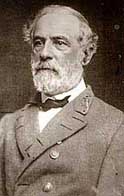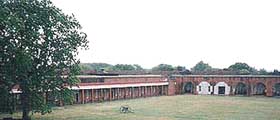
Robert
E. Lee's letter to his daughter reveals:
A
Father's Care for His Family, a Soldier's Concern about
His Country
 During the Civil War, Robert E.
Lee was beloved by civilians and soldiers of the South
for being a gentleman and a fearless leader. Though in
public he was calm and undemonstrative, in private he
revealed a warm, sentimental side to his family. During the Civil War, Robert E.
Lee was beloved by civilians and soldiers of the South
for being a gentleman and a fearless leader. Though in
public he was calm and undemonstrative, in private he
revealed a warm, sentimental side to his family.
In 1909, Robert E. Lee's youngest son, Robert E. Lee, II,
published his recollections of his father. In this volume
he also included his father's letters from the period of
1861 through 1870, the latter being the year in which he
died. A section of this book is devoted to letters he
wrote during the Civil War to his wife Mary and his
daughters Mary, Anne, Eleanor (Agnes), and Mildred. These
letters reveal the tender side of the stalwart general,
and express his affection for his family; his love of his
home, Arlington House; and his concern for his country.
The letter below was written to his daughter Anne on
March 2, 1862 while he was in Savannah, Georgia. A week
and a few days later, he would depart for Richmond.
There, at the capital of the Confederacy, Lee would be
appointed chief of staff of the Confederate armies. In
June he would assume the generalship of what he would
name the Army of Northern Virginia. His beloved
"Annie" would die later that year on October 20
at White Sulfur Springs, North Carolina, four months
after her 23rd birthday.
Above:
photo of General Lee by J.W. Davies, taken in 1863.
 |
|
Left: Arlington House,
built by George Washington Park Custis, was
completed in 1817. His daughter, Mary Anna
Randolph Custis, was married to Robert E. Lee in
this house in 1831. For 30 years the Lees lived
here, raising their seven children in this home
shared with Mary's parents. In 1864 the estate
was confiscated by the Federal government, and
200 acres were set aside for the establishment of
a military cemetery, known as Arlington National
Cemetery today. Arlington House became a part of
the National Park Service in 1933. |
| Photo
by CNO |

Savannah,
March 2, 1862
My Precious Annie: It has been a long time since I have
written to you, but you have been constantly in my
thoughts. I think of you all, separately and
collectively, in the busy hours of the day and the silent
hours of the night, and the recollection of each and
every one whiles away the long night, in which my anxious
thoughts drive away sleep. But I always feel that you and
Agnes at those times are sound asleep, and that it is
immaterial to either where the blockaders are or what
their progress is in the river. I hope you are all well,
and as happy as you can be in these perilous times to our
country. They look dark at present, and it is plain we
have not suffered enough, laboured enough, repented
enough, to deserve success. But they will brighten after
awhile, and I trust that a merciful God will arouse us to
a sense of our danger, bless our honest efforts, and
drive back our enemies to their homes. Our people have
not been earnest enough, have thought too much of
themselves and their ease, and instead of turning out to
a man, have been content to nurse themselves and their
dimes, and leave the protection of themselves and
families to others. To satisfy their consciences, they
have been clamorous in criticising what others have done,
and endeavoured to prove that they ought to do nothing.
This is not the way to accomplish our independence. I
have been doing all I can with our small means and slow
workmen to defend the cities and coast here. Against
ordinary numbers we are pretty strong, but against the
hosts our enemies seem able to bring everywhere there is
no calculating. But if our men will stand to their work,
we shall give them trouble and damage them yet. They have
worked their way across the marshes, with their dredges,
under cover of their gunboats, to the Savannah River,
about Fort Pulaski. I presume they will
endeavour to reduce the fort and thus open a way for
their vessels up the river. But we have an interior line
they must force before reaching the city. It is on this
line we are working, slowly to my anxious mind, but as
fast as I can drive them.... Good-bye, my dear child. May
God bless you and our poor country.
Your devoted father,
R.E. Lee.
Robert
E. Lee, The Recollections and Letters of General
Robert E. Lee, by His Son, Captain Robert E. Lee (New
York: Konecky & Konecky, 1992), pp. 65-66.

Fort Pulaski
 Fort Pulaski is located on
Cockspur Island off the coast of Georgia near Savannah.
Construction on the fort began in 1829 and lasted 18
years. As a young second lieutenant just out of West
Point, Robert E. Lee worked as an engineer in the early
stages of this project. With its moat, demilune (large,
triangular piece of land outside the front of the fort),
sophisticated drawbridge, and eight-foot-thick walls, the
fort was believed to be indomitable. But on April 11,
1862, the fort was finally breached when projectiles from
a Federal rifled cannon blasted through the southeastern
wall after 30 hours of bombardment. Rather than having
the fort blown up, it was surrendered to the Union. Fort Pulaski is located on
Cockspur Island off the coast of Georgia near Savannah.
Construction on the fort began in 1829 and lasted 18
years. As a young second lieutenant just out of West
Point, Robert E. Lee worked as an engineer in the early
stages of this project. With its moat, demilune (large,
triangular piece of land outside the front of the fort),
sophisticated drawbridge, and eight-foot-thick walls, the
fort was believed to be indomitable. But on April 11,
1862, the fort was finally breached when projectiles from
a Federal rifled cannon blasted through the southeastern
wall after 30 hours of bombardment. Rather than having
the fort blown up, it was surrendered to the Union.
Above:
Photo of the interior of Fort Pulaski by CNO. To the left
in this photo are rooms along the gorge wall that mainly
served as officers quarters; and to the right is the
Northwest Magazine that contained 40,000 pounds of
gunpowder and suffered damage when the Federals fired
upon the fort from April 10-11, 1862. Fort Pulaski
National Monument was established in 1924.

Journal Index | Next
Page
Back | Home
Copyright © 2001 - 2009 1st Dragoon's Civil War Site. All rights reserved.
Spider
Map Index
|

 During the Civil War, Robert E.
Lee was beloved by civilians and soldiers of the South
for being a gentleman and a fearless leader. Though in
public he was calm and undemonstrative, in private he
revealed a warm, sentimental side to his family.
During the Civil War, Robert E.
Lee was beloved by civilians and soldiers of the South
for being a gentleman and a fearless leader. Though in
public he was calm and undemonstrative, in private he
revealed a warm, sentimental side to his family.
 Fort Pulaski is located on
Cockspur Island off the coast of Georgia near Savannah.
Construction on the fort began in 1829 and lasted 18
years. As a young second lieutenant just out of West
Point, Robert E. Lee worked as an engineer in the early
stages of this project. With its moat, demilune (large,
triangular piece of land outside the front of the fort),
sophisticated drawbridge, and eight-foot-thick walls, the
fort was believed to be indomitable. But on April 11,
1862, the fort was finally breached when projectiles from
a Federal rifled cannon blasted through the southeastern
wall after 30 hours of bombardment. Rather than having
the fort blown up, it was surrendered to the Union.
Fort Pulaski is located on
Cockspur Island off the coast of Georgia near Savannah.
Construction on the fort began in 1829 and lasted 18
years. As a young second lieutenant just out of West
Point, Robert E. Lee worked as an engineer in the early
stages of this project. With its moat, demilune (large,
triangular piece of land outside the front of the fort),
sophisticated drawbridge, and eight-foot-thick walls, the
fort was believed to be indomitable. But on April 11,
1862, the fort was finally breached when projectiles from
a Federal rifled cannon blasted through the southeastern
wall after 30 hours of bombardment. Rather than having
the fort blown up, it was surrendered to the Union.